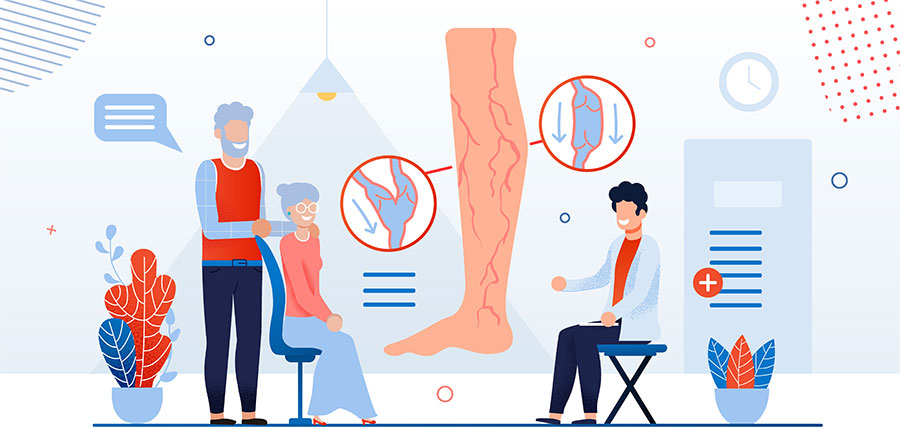
Endovenous Laser Treatment (EVLT)
A laser is a highly concentrated beam of light, very commonly used in several non-invasive medical procedures and is a very safe, effective and successful mode of treatment.
Endovenous laser treatment is the most widely used technique to treat varicose veins as well as spider veins in the legs. An Expert Interventional Radiologist, under duplex ultrasound guidance, passes a laser fiber through a small pinhole into the swollen, bulging varicose/spider veins. The laser generates heat which kills the walls of the veins and the resultant dead tissue is then naturally absorbed by the body and the malformed veins are thus destroyed.
Laser treatment for varicose and spider veins is much less painful in comparison to traditional vein ligation and stripping procedures that are mostly done under general anesthesia/sedation. The main advantage is that laser treatment of varicose veins requires only local or light sedation/anesthesia and has a shorter recovery period and the patient needs not to be admitted and can go home after the procedure.
Radiofrequency Ablation (RFA)
Vein Ablation is a minimally invasive process in which diseased tissue is damaged by using heat so as the resulting scar tissue closes the vein. It is a very effective, safe and highly successful treatment method.
Radiofrequency Ablation or RFA utilizes radiofrequency energy to heat up and damage the wall of the diseased vein from inside. Under image (ultrasound) guidance, a Specialist Interventional Radiologist inserts a radiofrequency catheter through a very small opening into the diseased vein. The surrounding tissue is protected by injecting the tumescent anesthetic solution as well as compression. Once the catheter is in place, heat is generated inside the vein which destroys the vein. The resulting scar tissue so formed closes the diseased vein.
Similar to laser treatment, radiofrequency ablation requires local or light sedation/anesthesia and has a very short recovery period. Patients are encouraged to do light walks and wear stockings/bandages after this treatment.
Ultrasound-guided Injection or Foam Sclerotherapy
Ultrasound-guided Injection Sclerotherapy is most conventional and safe treatment of choice for early small varicosities and often done for residul varicosities after Laser or RFA treatment.
In this procedure, the sclerosant medication is injected into the diseased veins while viewing the process on an ultrasound monitor. After injection, the treated vein will get scarred, shut and collapse down. This would make the blood reroute through healthy veins. The closed vein will eventually get dissolved and absorbed by local tissue.
This procedure is done in OPD room and takes around 15-20 minutes. As no anaesthesia is needed, the patient can resume work within 1 hour. The recovery period is very less and the treated veins will fade away in a few days.
This procedure is extremely useful and is a boon for the young candidates aspiring and preparing for Indian Armed Forces. Due to the excessive physical activity of calf muscles, army aspirants can get bulging varicose veins or spider veins in calf region. During medical fitness they are declared unfit for army service and asked for re‑medical after 3-4 weeks. With the help of Foam Injection Sclerotherapy, these veins will disappear within 1-2 weeks and recruits get “Fit” during fitness test.
VenaSeal
The above-listed ablation (Laser, RFA) procedures are the widely practised pin-hole procedures for varicose veins. However, the involvement of heat energy in these procedures necessitates the use of Tumescent Anesthesia (a very low dose of Lidocaine) so that the patient does not experience any pain from the surrounding nerves being affected.
Recently, a new minimally-invasive and very comfortable treatment modality for varicose veins has been developed known as the VenaSeal system. This is a non-thermal (no ablation/no heat) technique, therefore the patient no longer requires tumescent anesthesia with this procedure. This technique is considered one of the safest treatments for varicose veins.
The objective of the VenaSeal procedure is the same as the ablation. However, in this technique, this is done by delivering a small amount of specially-formulated medical glue (n-butyl-2-cyanoacrylate based formulation) through a very thin thread-like catheter to the diseased varicose vein to seal and shut it down. Usually, an expert Interventional Radiologist is able to complete the procedure within 30-40 minutes.
The main benefit of this technique is that very minimal to no pain is experienced by the patient. Also, the recovery period is very short; most patients typically recover within a day. Due to the diseased vein being glued shut, compression stockings are not mandatory (compulsory) after the procedure.




